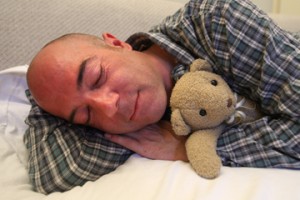
By Michael Bourguignon
“To sleep, perchance to dream – ay, there’s the rub.” – Hamlet
Indeed. Something as basic and essential as a good night’s sleep can be an elusive dream for sufferers of obstructive sleep apnea/hypopnea – and I should know.
Before the summer break, I wrote about my experience getting tested for the troublesome sleep disorder through the Royal Victoria Hospital’s Sleep Clinic.
Since then, the clinic’s director, John Kimoff, has filled me in on the options available to people, like me, whose sleep is disrupted by brief but persistent “episodes” during which we stop breathing.
The suggested treatments run the gamut from the conservative to the radical – not to mention the unexpected.
“There are different schools of thought about whether the upper airway muscles can be exercised and trained to alleviate apnea, but there’s an interesting study that suggests playing the didgeridoo could potentially help,” said Dr. Kimoff, referring to a 2005 study published in the British Medical Journal.
Doctor’s orders being perhaps one of the only acceptable reasons to endure the weird sounds of this aboriginal Australian wind instrument notwithstanding, I nonetheless inquire about other, more “sound” alternatives.
Because my condition is considered moderate and clearly affected by the position in which I sleep – I stop breathing an average of 27 times per hour, a stat that rises to 44 when I’m sleeping in my back – Dr. Kimoff reminds me that a few changes in habit could do the trick.
“Nightcaps are a big no-no,” he said. “Alcohol is bad for your sleep anyway.”
Nothing relaxes the throat muscles quite like a few belts of Scotch before bed and that’s precisely what I need to avoid. Same with cigarettes, which inflame the upper airway.
Then there’s the matter of trying to stay off my back, no mean feat when one is both horizontal and dead to the world. A number of homegrown remedies have been tried, with varying success.
“Some people sew tennis balls into the back of a t-shirt to prevent them rolling onto their backs at night, but that in itself can be disruptive,” Dr. Kimoff explained. “Other people wear a small backpack.”
Since neither option sounds particularly appealing to me, we move on to the more medical – and expensive – methods of treatment, such as the wide array of oral appliances designed to thrust the jaw forward and keep the airway open.
“You need to interact with a dentist for this and you need to find a dentist who has extensive knowledge and experience in manufacturing these devices,” Dr. Kimoff cautioned. “A lot of dentists are now getting into this market, but you need to ask them, ‘How many of these have you made and have you taken courses?’”
At $1,500 to $2,000 a pop – not necessarily covered by insurance – sticking a useless appliance into your mouth at night is not going to help you sleep any better.
For that price, I could get a Continuous Positive Airway Pressure (CPAP) machine, far and away Dr. Kimoff’s preferred method of treatment.
“This is a mask attached to a small box next to your bed that blows open the throat using a tube either through the nose or the mouth,” he explained. “CPAP is a wonderful treatment for people with moderate to severe apnea. Some people never get used to it because it can be annoying, but other people love it and can’t imagine life without it.”
At the far end of the treatment scale is surgery to remove tissue and permanently enlarge the airway, a radical option that Dr. Kimoff said is largely ineffective for people with severe apnea.
Leaving me with plenty to ponder, Dr. Kimoff recommends I try the lifestyle changes first and, if those don’t work, we’ll talk again about oral appliances, CPAP and such.
I’m not about to sew tennis balls into t-shirts, but whatever path I choose, Dr. Kimoff offers one last piece of advice: “Your benefit will be in direct proportion to your compliance with the treatment.”
So if you ever catch me napping at my desk, drink in one hand, cigarette in the other, and a disused CPAP machine at my side, feel free to chastise.
Editor’s note: Michael Bourguigon left McGill earlier this summer to take up a position with the Canadian Blood Agency in Ottawa. He kindly consented to having us publish the follow-up to his initial story about dealing with apnea.
